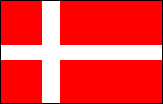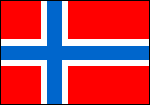|
6th World Junior Bridge Teams Championship DAILY BULLETIN Editor: M. Horton • Co-Editor: R. Lee Web Editor: Th. Matziaris No.: 10 • Wedneday, 13 August 1997 |
| Results | Contents |
| Danish Dynamite |
|
Clean Sweep for Europe
Building on their overnight lead, Denmark were never in danger in today's final two sessions, winning the final by 247.7 IMPs to 178 over Norway. The gold medallists are: Fred Brøndum, Mik Kristensen, Lars Lund Madsen, Morten Lund Madsen, Mikkel Nøhr, Jacob Røn, Kirsten Steen Møller (npc), Nicolai Kampmann (coach). Winning the silver medal was Norway: Boye Brogeland, Oeyvind Saur, Bjoern Morten Mathisen, Christer Kristoffersen, Espen Erichsen, Thomas Charlsen, Sten Bjertnes (npc), Harals Skjaeran (coach). For Denmark, it is the end of a steady progression in the World Junior Teams: 6th in 1991, 4th in 1993, 3rd in 1995, and now finally the champions. The bronze medal was won on Tuesday by Russia: Arseni Chour, Youri Khokhlov, Youri Khiouppenen, Dmitry Lobov, Alexandre Petrounine, Boris Sazonov, Michael Rosenblum (npc). |
| Final - 4th quarter |

|
Denmark vs Norway |
 |
|
This was a much tighter set than the third quarter had been. After a couple of early Norwegian gains, Denmark recovered and continued to build their lead. They ended with a useful margin of 31.7 IMPs, which they took into the last 32 boards today. Meanwhile, little was going right for Canada Red, as Russia gained a further 19 IMPs in a high-scoring session, to win the bronze medal playoff by 41 IMPs. Here are a few of the highlights.
Looking at the East-West hands, you probably don't want to be in any game
contract. If you have to pick one, perhaps 4
An unexceptional little hand, you may muse - why would it be included here? True, the bidding and play were largely unremarkable, but the other events on the board were not. Røn and Brøndum had both bid diamonds, and at the end of the auction they were both under the misapprehension that they were going to be dummy. In a friendly fashion, each showed his hand to his screen-mate while awaiting the opening lead! Erichsen was now defending double dummy, which is not a term that describes Brøndum's line of play: he proceeded to misguess clubs, diamonds, and hearts, and give up 4 IMPs.
With eighteen total trumps on this hand in clubs and hearts, it appears that
both sides belong at the three-level. Indeed, double dummy it is possible to
make ten tricks in hearts, although in practice declarer is likely to end up
with a trump loser for only nine tricks. Morten Madsen passed in second
chair, and as a result was never selling out to 3 One of Canada Red's few successes came on this hand, when they
essayed a skimpy 3NT from the North hand, against which the defence could have
taken the first eleven tricks. However, East led the
Timing is everything, and the fate of this hand depended on who got to open
their weak two bid. Erichsen regarded the West hand as a routine 2
This is a tricky hand to bid for both sides. What do you bid as North when
your partner opens 1 The other trap on this hand is 4 | |||||||||||||||||||||||||||||||||||||||||||||||||||||||||||||||||||||||||||||||||||||||||||||||||||||||||||||||||||||||||||||||||||||||||||||||||||||||||||||||||||||||||||||||||||||||||||||||||||||||||||||||||||||||||||||||||||||||||||||||||||||||||||||||||||||||||||||||||||||||||||||||||||||||||||||||||||||||||||||||||||||||||||||||||||||||||||||||||||||||||||||||||||||||||||||||||||||||||||||||||||||||||||||||||||||||||||||||||||||||||||||||||||||||||||||||||||||||||||||||||||||||||||||||||||||||||||||||||||||||||||||||||||||||||||||||||||||||||||||||||||||||||||||||||||||||||||||||||||||||||||||||||||||||||||||||||||||||||||||||||||||||||||||||||||||||
| Have you discussed? by Derek Rimington |
|
Here is a defensive problem for you (East) to solve. It is easier if you and your partner have met this type of problem before:
West leads the king of clubs. Although your partnership's lead conventions are Rusinow (Roman) - second highest from an honour sequence, the king from ace-king is standard in expert circles against high level pre-empts. (Some experts lead the ace for attitude and the king for count) You therefore discourage with the two. As expected, your partner switches and chooses to play the king of spades. This time you encourage a continuation by signalling with the nine and South plays the three. West continues with the queen of spades. Do you complete your peter with the five or overtake with the ace? If the latter, what do you return? For readers who do not recognise the two hands, I put them in context. The full deal occurred in 1971 in Las Vegas. The Italian Blue Team had announced their retirement from World Championship play in 1969 after winning the Bermuda Bowl in Rio de Janeiro. The Dallas Aces had taken over, winning the World Teams Championship in 1970 in Stockholm when representing North America and had again won under their own banner in Taipei in 1971. To test their mettle against the Italian maestros a $15,000 challenge match over 140 boards had been arranged in Las Vegas, Blue Team versus Dallas Aces. This was one of the hands and the full deal was:
In the match, Pietro Forquet found the winning action of overtaking
Benito Garozzo's queen and returning the five of spades for the
vital ruff. Did you? It has never been made clear what caused Pietro to
deduce that Bobby Wolff held an unlikely five-card spade suit. It may
have been simply that the famous Italian partnership had agreed to use Roman
leads at trick two as well as initially. The spade king followed by the queen
would then indicate a doubleton, because with The usual methods are to use Roman leads only to the first trick. The one exception to this practice is to lead the king from ace, king and others once dummy is exposed (note that this is normal procedure with standard leads). A more likely explanation is that the Italians 'had been there before'. If Benito Garozzo had held king, queen and at least one other spade, he would have led a low spade to trick three. Which explanation do you prefer? Perhaps either Benito or Pietro will see this article and volunteer an explanation. The less gifted of us would like to know. Finally the result of the challenge match was that the Blue Team won by 338 to 254 IMPs and were enticed back to contest the 1972 Olympiad in Miami which they won! In the final, Italy (Avarelli, Belladonna, D'Alelio, Forquet, Garozzo and Pabis-Ticci) defeated the USA (Goldman, Hamman, Jacoby, Lawrence, Soloway and Wolff) by 203-138 IMPs. Italy went on to win the Bermuda Bowl in each of the next three years. Shall we ever see their like again? | ||||||||||||||||||||||||||||||||||||||||||||||||||||||||||||||||||||||||||||||||||||||||||||||||||||||||||||||||||||||||
| To List of Bulletins |